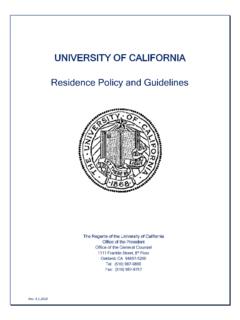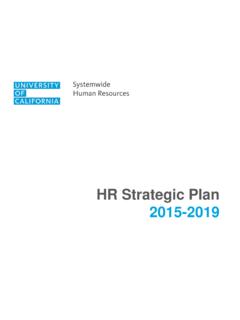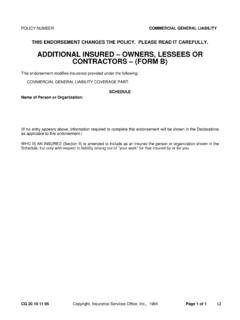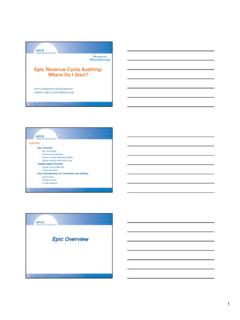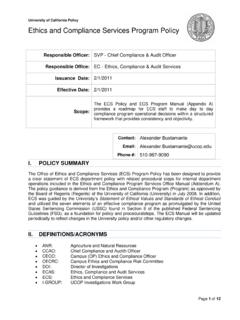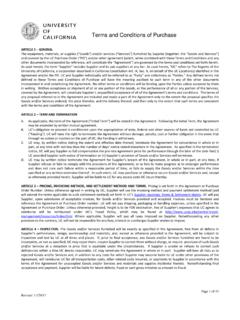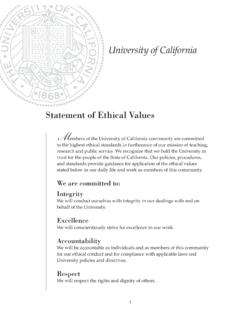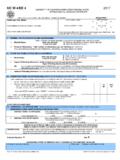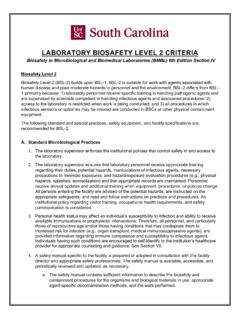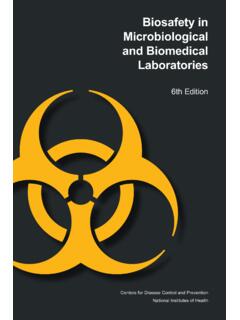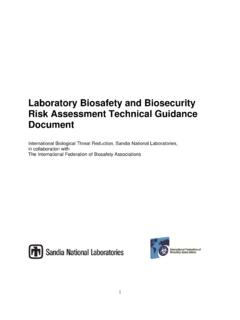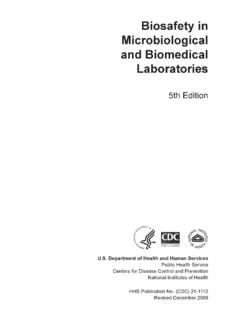Transcription of Biosafety Level 3 (BSL-3) Laboratory Design Standards
1 Biosafety Level 3 (BSL-3) Laboratory Design Standards January 2020 CC Noncommercial License This manual is licensed under a Creative Commons Attribution-NonCommercial International License. When reusing the content under this license, please provide (1) attribution to Environment, Health & Safety at the University of California, Office of the President ; (2) the following copyright notice: The Regents of the University of California; and (3) if feasible, a hyperlink to where the original source material appears. C BSL-3 Laboratory Design Standards FINAL VERSION JAN 2020 II Introduction The University of California (UC) is home to some of the world s most advanced and pioneering biomedical science and clinical research. Consistently ranked among the leaders in the field of Infectious Disease research, the UC is often called upon to provide critical expertise in response to worldwide public health crises.
2 Infectious Disease research involving highly pathogenic and primarily aerosol transmissible agents ( , Risk Group 3 agents) has the potential to present significant risk to individuals, the community, and the environment. The ability to safely conduct these research activities is largely dependent upon the highly engineered Biosafety Level 3 (BSL-3) Laboratory , the highest- Level containment facilities currently operated by the UC. The primary objective of these laboratories is to provide the best possible physical containment of Risk Group 3 agents. Hence, the Design and engineering of these laboratories must be maintained at the highest attainable Standards . Several authorities have published Standards for the Design of BSL-3 laboratories. Development of the UC Biosafety Level 3 Design Standards has incorporated input from several of these sources, including the following: CDC Biosafety in Microbiological and Biomedical Laboratories (BMBL), 5th Edition, 2009 NIH Design Requirements Manual for Biomedical Laboratories and Animal Research Facilities (DRM), 2019 NIH Guidelines for Research Involving Recombinant or Synthetic Nucleic Acid Molecules (NIH Guidelines), 2016 National Institutes of Health Biosafety Level 3 Laboratory Certification Requirements, 2006 Industry Standards and Best Practices The information presented in these Standards addresses facility Design and engineering systems for BSL-3 containment laboratories and incorporates additional Design elements to assist campuses in conducting facility risk assessments.
3 It is important to note that an effective BSL-3 program is not only reliant upon the facility and engineering, but also operation and maintenance (O&M) protocols, robust training programs, administrative controls, and standard operating procedures (SOPs). Application The BSL-3 Laboratory Design Standards represent the UC requirements for constructing BSL-3 laboratories. These Standards need to be referenced and used by UC Design teams including C BSL-3 Laboratory Design Standards FINAL VERSION JAN 2020 III researchers, architects and engineers, as well as outside contractors. They provide necessary tools and information for BSL-3 planning, construction, and commissioning on UC campuses. While incorporating all applicable regulatory requirements, the Standards identify UC requirements, provide explanations of those Standards , and document best practices for consideration during the facility risk assessment.
4 This range of acceptable parameters will allow campuses to build each Laboratory with a Level of features commensurate with the facility risk assessment. These Standards pertain to new facility builds and/or major renovations or retrofits of existing BSL-3 Laboratory space. It is not the intent of these Standards to require upgrades to existing BSL-3 spaces, but to provide Design Standards and guidance when embarking on a new construction or major renovation project. For the purposes of these Design Standards , major renovations/retrofits are defined as any of the following: 1. Changes to fixed primary containment equipment ( ducted BSCs or any other devices connected to the BSL-3 exhaust system); 2. Changes to major HVAC systems/components ( exhaust fans, air handling units, airflow control valves, isolation dampers, Building Management Systems / Building Automation Systems (BMS/BAS), ductwork, etc.)
5 ; 3. Changes to floorplans or structural components of the secondary containment boundaries ( walls, ceilings, or attached fixtures); 4. Any other changes to the facility that could impact overall safety, operations, or ventilation system performance. This Standard is applicable to the specific retrofit and not meant to apply to the entire facility. As plans to renovate specific features of an existing facility evolve, it is important to address any identified issues that may affect the safe operations of a BSL-3 Laboratory , potentially presenting a risk to the UC community or the environment. These Standards have been approved by the UC systemwide High Containment Laboratory Oversight Committee (HCLOC), and shall be incorporated or referenced in Campus Building Standards . Note: Facilities required to comply with the Federal Select Agent Program and/or Dual Use Research of Concern may have additional Biosafety or biosecurity Design features beyond these UC Standards .
6 In addition to the UC Standards , campuses must reference and comply with the applicable Federal regulatory Standards when designing Federal Select Agent or Dual Use Research high-containment facilities. Campus Involvement At the onset of a new BSL-3 Laboratory or existing Laboratory renovation Design project, it is important to consider the involvement of specific campus experts. Consultation with these key campus members may provide insight into critical Design flaws that may affect specific aspects of the Laboratory s functionality. These contributions could prove to be exceptionally cost-effective in C BSL-3 Laboratory Design Standards FINAL VERSION JAN 2020 IV terms of both time and resources. Involvement from the following campus members is recommended: PI (researcher)/Department Chair EH&S Biosafety High Containment Laboratory Director Campus Design Management Group Capital Programs UC Building Officials Campus ADA Reviewer Campus Security or Campus Police Department Campus Emergency Response Campus Fire Marshal Campus Facilities Operations & Management Group Deviations Campuses must comply with the UC Biosafety Level 3 Design Standards and Best Practices should be considered when appropriate.
7 When justified by a documented risk assessment, a deviation may be considered. A campus seeking a deviation approval must first complete the UC BSL3 Design Standards Deviation Request Form, Appendix I. The completed form and requested documentation shall be presented to the campus High Containment Laboratory Oversight Group (HCLOG) for approval. With campus HCLOG approval, the deviation request will be presented to the UC systemwide HCLOC, for final approval. Revisions to the Standards A full review and revision of the UC BSL3 Design Standards shall be conducted every two years, on even years. Between full revisions, the Design Standards may be revised on an as needed basis via continual evaluation and application. Through the use of these Design Standards , any identified gaps, errors, or sections requiring further clarification will be noted and highlighted by local EH&S and Design professionals.
8 Corrections, clarifications and all identified issues shall be presented to the UC systemwide HCLOC for confirmation and approval. Once approved by the HCLOC, updates will be completed and distributed to each location. Revised versions of the Standards must receive approval by the UC systemwide HCLOC prior to implementation. C BSL-3 Laboratory Design Standards FINAL VERSION JAN 2020 V Table of Contents List of Codes, Standards and Guidelines .. 1 BSL-3 2 General .. 2 Containment Barrier .. 3 Anterooms .. 4 Doors .. 5 Windows .. 6 Floors .. 7 Base .. 7 Walls .. 7 Ceilings .. 8 Access Panels .. 9 Finishes .. 9 Furniture .. 10 Sealing .. 11 BSL-3 Architectural References .. 13 Heating, Ventilation & Air Conditioning .. 19 HVAC References .. 24 Electrical .. 27 Electrical References .. 34 Plumbing .. 38 Water Distribution .. 39 Vacuum 39 Sinks .. 40 Shower.
9 41 Drains .. 41 Traps .. 42 Waste Pipe 43 C BSL-3 Laboratory Design Standards FINAL VERSION JAN 2020 VI Plumbing References .. 44 Telecom, Security & Documentation .. 47 Telecom .. 47 Security .. 47 Signage .. 49 Enhanced Facilities .. 50 Verification & Documentation .. 50 Seismic .. 51 Telecom, Security & Documentation References .. 52 Safety and 53 Safety .. 53 Decontamination .. 55 Safety and Decontamination References .. 57 BSL-3 Standard Equipment .. 59 Autoclaves .. 59 Biosafety Cabinets .. 60 Flow Cytometry .. 61 Centrifuge .. 61 BSL-3 Standard Equipment References .. 62 CC Noncommercial License This manual is licensed under a Creative Commons Attribution-NonCommercial International License. When reusing the content under this license, please provide (1) attribution to Environment, Health & Safety at the University of California, Office of the President ; (2) the following copyright notice: The Regents of the University of California; and (3) if feasible, a hyperlink to where the original source material BSL-3 Laboratory Design Standards FINAL VERSION JAN 2020 1 List of Codes, Standards and Guidelines Biosafety in Microbiological and Biomedical Laboratories (BMBL) 5th Edition, 2009 The BMBL is published jointly by the Department of Health and Human Services, the Centers for Disease Control and the National Institutes of Health.
10 The document describes Biological risk assessment, lab practices, safety equipment, and facilities requirements required for designing and operating laboratories at Biosafety Levels (BSL) 1 through 4. Although not a code, certification of BSL facilities is dependent on following the recommendations in this document. NIH Design Requirements Manual (DRM) 2019 Rev : 4/24/19 National Institutes of Health Biosafety Level 3 Laboratory Certification Requirements, July 2006 ANSI/ASSE Testing and Performance-Verification Methodologies for Ventilation Systems for Biosafety Level 3 (BSL-3) and Animal Biosafety Level 3 (ABSL-3) Facilities - This document can be purchased at: NIH Guidelines for Research Involving Recombinant or Synthetic Nucleic Acid Molecules (NIH Guidelines), 2016 University of California Environment, Health & Safety (EH&S) Laboratory Safety Design Guide, Second Edition, September 2007 C BSL-3 Laboratory Design Standards FINAL VERSION JAN 2020 2 BSL-3 Architectural General Standard Explanation Best Design Practice New UC BSL-3 laboratories and designated retrofits must be reviewed for compliance with applicable provisions of the American with Disabilities Act (ADA) and related codes and regulations.
